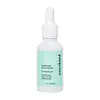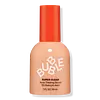What's inside
What's inside
 Key Ingredients
Key Ingredients

 Benefits
Benefits

 Concerns
Concerns

 Ingredients Side-by-side
Ingredients Side-by-side

Salicylic Acid 1.5%
MaskingAloe Barbadensis Leaf Juice
Skin ConditioningPropanediol
SolventGlycerin
HumectantSodium Citrate
BufferingMusa Sapientum Fruit Extract
Skin ConditioningGluconolactone
Skin ConditioningLysolecithin
EmulsifyingSclerotium Gum
Emulsion StabilisingMaltodextrin
AbsorbentSodium Benzoate
MaskingSodium Hydroxide
BufferingPullulan
Xanthan Gum
EmulsifyingLactobacillus Ferment
Skin ConditioningTocopherol
AntioxidantSilica
AbrasiveHelianthus Annuus Seed Oil
EmollientCalcium Gluconate
HumectantBeta-Glucan
Skin Conditioning1,2-Hexanediol
Skin ConditioningCaprylyl Glycol
EmollientPyrus Malus Fruit Extract
Skin ConditioningMorinda Citrifolia Fruit Extract
Skin ConditioningSalicylic Acid 1.5%, Aloe Barbadensis Leaf Juice, Propanediol, Glycerin, Sodium Citrate, Musa Sapientum Fruit Extract, Gluconolactone, Lysolecithin, Sclerotium Gum, Maltodextrin, Sodium Benzoate, Sodium Hydroxide, Pullulan, Xanthan Gum, Lactobacillus Ferment, Tocopherol, Silica, Helianthus Annuus Seed Oil, Calcium Gluconate, Beta-Glucan, 1,2-Hexanediol, Caprylyl Glycol, Pyrus Malus Fruit Extract, Morinda Citrifolia Fruit Extract
Salicylic Acid 2%
MaskingWater
Skin ConditioningGlycerin
HumectantSqualane
EmollientOctyldodecyl Stearoyl Stearate
EmollientSodium Polyacryloyldimethyl Taurate
Emulsion StabilisingSodium Polyacrylate
AbsorbentCetearyl Alcohol
EmollientCentella Asiatica Leaf Extract
Skin ConditioningColloidal Oatmeal
AbsorbentSalvia Officinalis Leaf Extract
CleansingZinc PCA
HumectantDipotassium Glycyrrhizate
HumectantMelia Azadirachta Seed Oil
EmollientSpiraea Ulmaria Flower Extract
Skin ConditioningSalix Nigra Bark Extract
Skin ProtectingXanthan Gum
EmulsifyingCoco-Glucoside
CleansingTocopheryl Acetate
AntioxidantPotassium Hydroxide
BufferingCitric Acid
BufferingPhenoxyethanol
PreservativeSalicylic Acid 2%, Water, Glycerin, Squalane, Octyldodecyl Stearoyl Stearate, Sodium Polyacryloyldimethyl Taurate, Sodium Polyacrylate, Cetearyl Alcohol, Centella Asiatica Leaf Extract, Colloidal Oatmeal, Salvia Officinalis Leaf Extract, Zinc PCA, Dipotassium Glycyrrhizate, Melia Azadirachta Seed Oil, Spiraea Ulmaria Flower Extract, Salix Nigra Bark Extract, Xanthan Gum, Coco-Glucoside, Tocopheryl Acetate, Potassium Hydroxide, Citric Acid, Phenoxyethanol
 Reviews
Reviews

Ingredients Explained
These ingredients are found in both products.
Ingredients higher up in an ingredient list are typically present in a larger amount.
Glycerin is already naturally found in your skin. It helps moisturize and protect your skin.
A study from 2016 found glycerin to be more effective as a humectant than AHAs and hyaluronic acid.
As a humectant, it helps the skin stay hydrated by pulling moisture to your skin. The low molecular weight of glycerin allows it to pull moisture into the deeper layers of your skin.
Hydrated skin improves your skin barrier; Your skin barrier helps protect against irritants and bacteria.
Glycerin has also been found to have antimicrobial and antiviral properties. Due to these properties, glycerin is often used in wound and burn treatments.
In cosmetics, glycerin is usually derived from plants such as soybean or palm. However, it can also be sourced from animals, such as tallow or animal fat.
This ingredient is organic, colorless, odorless, and non-toxic.
Glycerin is the name for this ingredient in American English. British English uses Glycerol/Glycerine.
Learn more about GlycerinSalicylic Acid (also known as beta hydroxy acid or BHA) is a well-known ingredient for treating skin that struggles with acne and clogged pores. It exfoliates both the skin's surface and deep within the pores to help clear out buildup, control oil, and reduce inflammation.
Unlike AHAs (alpha hydroxy acids), salicylic acid is oil-soluble. This allows it to penetrate into pores which makes it especially effective for treating blackheads and preventing future breakouts.
Salicylic acid is also known for its soothing properties. It has a similar structure to aspirin and can calm inflamed or irritated skin, making it a good option for acne-prone skin that is also sensitive.
Concentrations of 0.5-2% are recognized by the U.S. FDA as an over-the-counter topical acne product.
It can cause irritation and/or dryness if one's skin already has a compromised moisture barrier, so it's best to focus on repairing that before introducing this ingredient into your routine.
While salicylic acid does not increase sun sensitivity, it’s still important to wear sunscreen daily to protect your skin.
If you are looking for the ingredient called BHA or Butylated Hydroxyanisole, click here.
Learn more about Salicylic AcidXanthan gum is used as a stabilizer and thickener within cosmetic products. It helps give products a sticky, thick feeling - preventing them from being too runny.
On the technical side of things, xanthan gum is a polysaccharide - a combination consisting of multiple sugar molecules bonded together.
Xanthan gum is a pretty common and great ingredient. It is a natural, non-toxic, non-irritating ingredient that is also commonly used in food products.
Learn more about Xanthan Gum